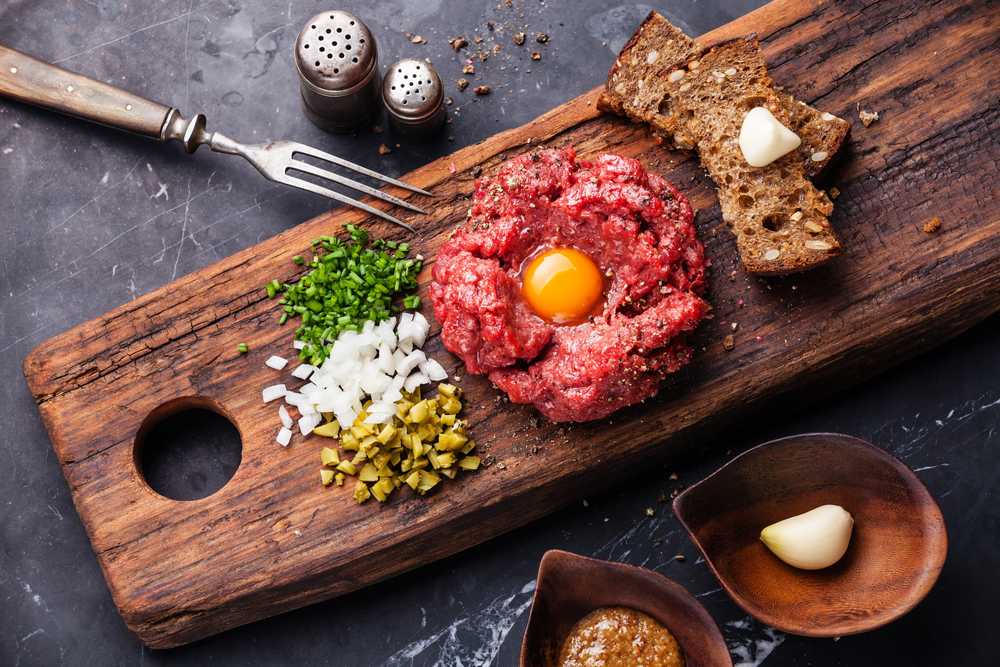Beef tartare is a classic dish with roots deeply planted in European cuisine, particularly popular in France. It’s a delicacy made from raw, finely chopped or minced beef, typically seasoned and served with various accompaniments that enhance its flavor. This dish is celebrated for its simplicity, which allows the quality of the meat to shine through. Crafting the perfect beef tartare requires attention to detail, starting from selecting the right cut of beef to the final plating. Here’s a guide to making a classic beef tartare at home, along with tips to ensure safety and deliciousness.
Ingredients
500g of high-quality beef fillet, very fresh
1 small shallot, finely chopped
2 tablespoons of capers, rinsed and chopped
2 teaspoons of Dijon mustard
1 tablespoon of olive oil
1 egg yolk (optional)
Salt and freshly ground black pepper, to taste
A few drops of Worcestershire sauce (optional)
A few drops of Tabasco sauce (optional)
Fresh parsley, chopped (for garnish)
Toasted bread or crackers, to serve
Instructions
Prepare the Beef: Start by placing the beef in the freezer for about 20 minutes. This will firm it up slightly, making it easier to chop finely without it becoming mushy. After chilling, use a sharp knife to trim any fat or sinew from the beef fillet, then finely chop the meat. You can also mince it if you prefer a finer texture. Transfer the chopped beef to a mixing bowl.
Season the Meat: To the bowl, add the finely chopped shallot, capers, and Dijon mustard. If using, you can also add the Worcestershire sauce and Tabasco for a bit of a kick. Drizzle the olive oil over the mixture, then season with salt and pepper. Mix gently until all ingredients are well combined.
Egg Yolk (Optional): If you choose to include an egg yolk, make a small well in the center of the beef mixture and carefully place the yolk in it. This is traditional and adds richness to the dish, but it’s optional based on personal preference.
Plating: Serve the tartare immediately after mixing. You can use a ring mold to plate it for a more refined presentation. Place the mold on the serving plate, fill it with the beef mixture, then gently remove the mold. Garnish with chopped parsley.
Serve: Accompany the beef tartare with toasted bread or crackers. This adds a crunchy texture contrast to the softness of the tartare.
Safety Tips
Select Quality Meat: Always use the freshest, highest quality beef you can find, preferably from a reputable butcher.
Hygiene: Ensure all utensils, cutting boards, and your hands are thoroughly cleaned before preparing the dish.
Serving Time: Due to its raw nature, beef tartare should be prepared fresh and served immediately to minimize the risk of bacterial growth.
Variations
Beef tartare is a versatile dish, and you can tailor it to your taste. Some like to add finely chopped pickles for an extra tang or incorporate different herbs for a fresh twist.
Experimenting with the seasonings and accompaniments can make the dish uniquely yours.
Beef tartare is more than just a meal; it’s a culinary experience that delights the senses. Its rich history and simplicity have made it a beloved classic around the world. With high-quality ingredients and a bit of care, you can bring this gourmet dish into your kitchen and impress your guests with your culinary prowess.
Understanding Beef Tartare
Beef tartare isn’t just a recipe; it’s a tradition that showcases the art of preparing raw dishes with elegance and respect for the ingredients. The origins of the dish are often debated, with some attributing its name to the Tartars of Central Asia, though the version we know and love today is distinctly European, particularly French.
The Importance of Meat Quality
The key to an exquisite beef tartare lies in the quality of the meat. Opt for beef fillet, also known as tenderloin, for its tenderness and lean texture. The freshness of the beef is paramount since it will be consumed raw. It’s advisable to talk to your butcher, informing them that you intend to prepare tartare, ensuring you get the best cut, handled with care.
Customizing Your Tartare
While the classic beef tartare recipe is a great starting point, the dish is a canvas for creativity. Here are a few ideas to customize your tartare:
Cheese: A small amount of finely grated Parmesan or pecorino can add depth.
Herbs: Beyond parsley, consider chervil, tarragon, or cilantro for different flavor profiles.
Acid: Lemon juice or a high-quality vinegar can brighten the dish.
Textures: Incorporate finely diced cucumber or radishes for crunch.
Serving Suggestions
While traditionally served with toasted bread, beef tartare can also be accompanied by a light salad, such as arugula or watercress, dressed simply with lemon juice and olive oil. This not only adds a fresh element but also balances the richness of the meat.
Nutritional Considerations
Beef tartare is rich in protein and can be part of a balanced diet. However, it’s also high in cholesterol, particularly with the addition of an egg yolk. As with all dishes, especially those involving raw ingredients, moderation is key.
Addressing Safety Concerns
Eating raw beef may raise concerns about foodborne illnesses. Minimizing risk involves not just selecting the freshest possible ingredients but also maintaining a clean preparation environment. Additionally, pregnant women, young children, the elderly, and those with compromised immune systems should avoid raw meat.
The Social Aspect of Tartare
Beyond its flavors and textures, beef tartare often serves as a centerpiece for gatherings, offering a shared experience that is both gourmet and somewhat adventurous. Preparing tartare can be a talking point, showcasing culinary skills and a commitment to quality.
Beef tartare is a testament to the beauty of simplicity in cooking, proving that when high-quality ingredients are treated with respect and care, the result is nothing short of spectacular. Whether enjoying a classic version or experimenting with variations, the experience of making and serving beef tartare is sure to be memorable. As with any dish involving raw meat, the emphasis on freshness, quality, and cleanliness cannot be overstated, ensuring that this luxurious dish can be enjoyed with both delight and peace of mind.




